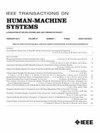Real-Time Myoelectric-Based Neural-Drive Decoding for Concurrent and Continuous Control of Robotic Finger Forces
IF 4.4
3区 计算机科学
Q2 COMPUTER SCIENCE, ARTIFICIAL INTELLIGENCE
引用次数: 0
Abstract
Neural or muscular injuries, such as due to amputation, spinal cord injury, and stroke, can affect hand functions, profoundly impacting independent living. This has motivated the advancement of cutting-edge assistive robotic hands. However, unintuitive myoelectric control of these devices remains challenging, which limits the clinical translation of these devices. Accordingly, we developed a robust motor-intent decoding approach to continuously predict the intended fingertip forces of single and multiple fingers in real time. We used population motor neuron discharge activities (i.e., neural drive from brain to spinal cord) decoded from a high-density surface electromyogram (HD-sEMG) signals as the control signals instead of the conventional global sEMG features. To enable real-time neural-drive prediction, we employed a convolutional neural network model to establish the mapping from global HD-sEMG features to finger-specific neural-drive signals, which were then employed for continuous and real-time control of three prosthetic fingers (index, middle, and ring). As a result, the neural-drive-based approach can decode the motor intent of single-finger and multifinger forces with significantly lower force estimation errors than that obtained using the global HD-sEMG-amplitude approach. Besides, the force prediction accuracy was consistent over time and demonstrated strong robustness to signal interference. Our network-based decoder can also achieve better finger isolation with minimal forces predicted in unintended fingers. Our work demonstrates that the accurate and robust finger force control could be achieved through this new decoding approach. The outcomes offer an efficient intent prediction approach that allows users to have intuitive control of prosthetic fingertip forces in a dexterous way.基于神经驱动的实时肌电解码,实现机器人手指力的并发和连续控制
神经或肌肉损伤,如截肢、脊髓损伤和中风,会影响手部功能,严重影响独立生活。这推动了尖端辅助机器人手的发展。然而,这些装置不直观的肌电控制仍然具有挑战性,这限制了这些装置的临床应用。因此,我们开发了一种鲁棒的运动意图解码方法,以实时连续预测单个和多个手指的预期指尖力。我们使用高密度表面肌电图(HD-sEMG)信号解码的群体运动神经元放电活动(即从大脑到脊髓的神经驱动)作为控制信号,而不是传统的全局肌电图特征。为了实现实时神经驱动预测,我们采用卷积神经网络模型建立了从全局HD-sEMG特征到手指特异性神经驱动信号的映射,然后将其用于连续实时控制三个假手指(食指,中指和无名指)。因此,基于神经驱动的方法可以解码单指和多指力的运动意图,并且与使用全局hd - semg振幅方法获得的力估计误差显着降低。力预测精度随时间保持一致,对信号干扰具有较强的鲁棒性。我们的基于网络的解码器也可以实现更好的手指隔离,以最小的力预测意外的手指。我们的工作表明,通过这种新的解码方法可以实现准确和鲁棒的手指力控制。结果提供了一种有效的意图预测方法,允许用户以灵巧的方式直观地控制假肢指尖的力量。
本文章由计算机程序翻译,如有差异,请以英文原文为准。
求助全文
约1分钟内获得全文
求助全文
来源期刊

IEEE Transactions on Human-Machine Systems
COMPUTER SCIENCE, ARTIFICIAL INTELLIGENCE-COMPUTER SCIENCE, CYBERNETICS
CiteScore
7.10
自引率
11.10%
发文量
136
期刊介绍:
The scope of the IEEE Transactions on Human-Machine Systems includes the fields of human machine systems. It covers human systems and human organizational interactions including cognitive ergonomics, system test and evaluation, and human information processing concerns in systems and organizations.
 求助内容:
求助内容: 应助结果提醒方式:
应助结果提醒方式:


